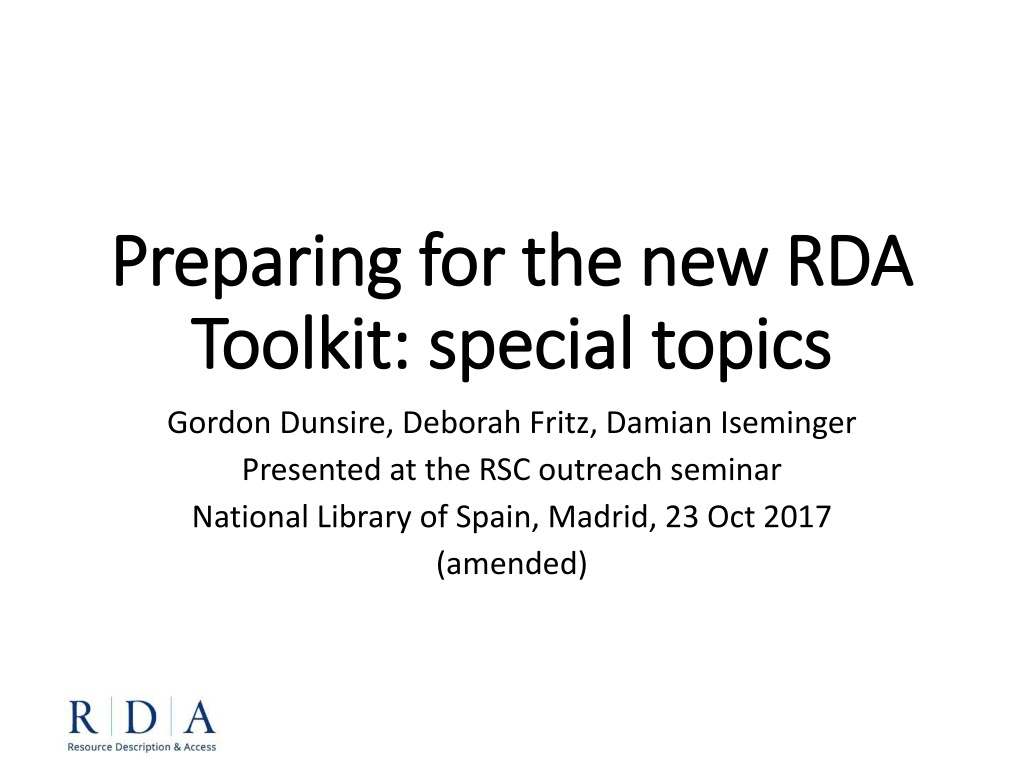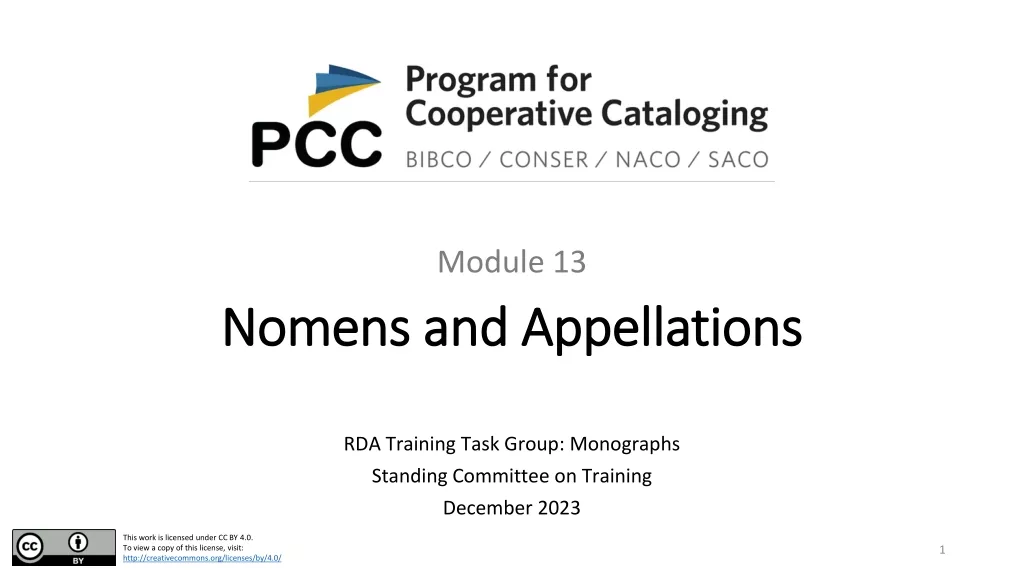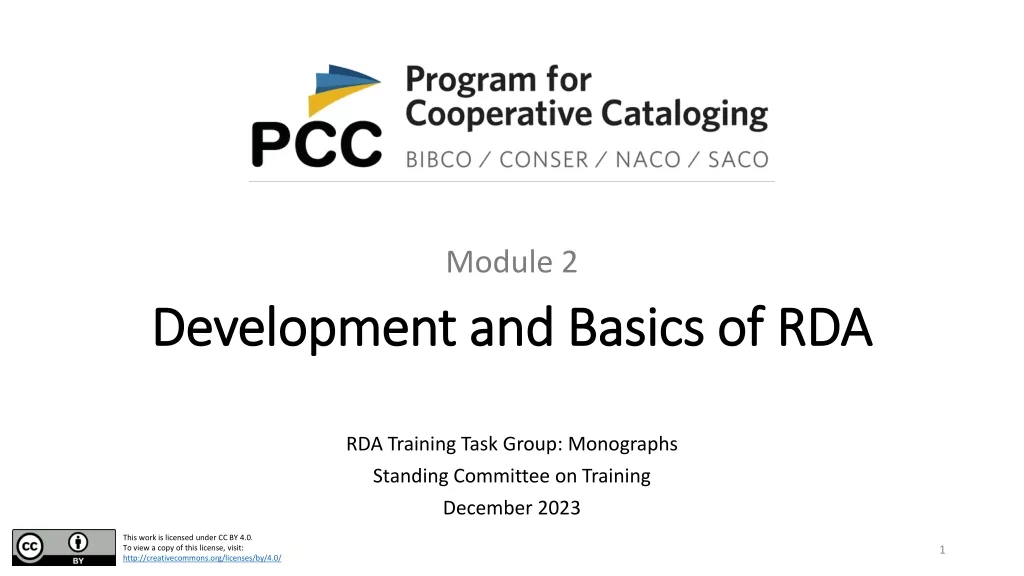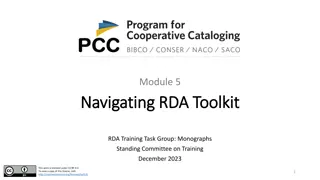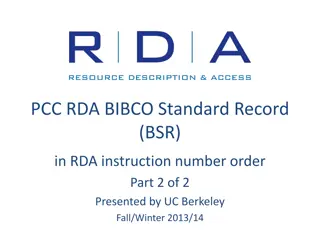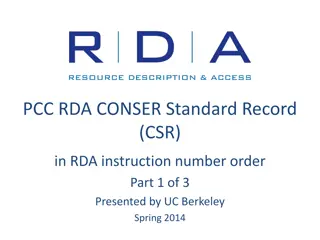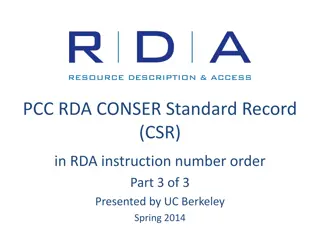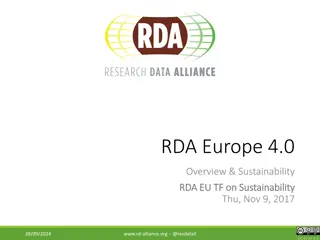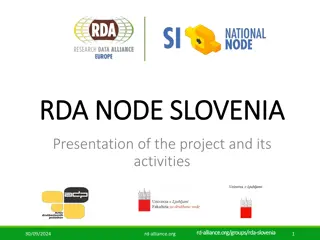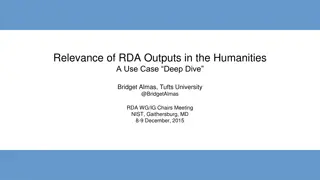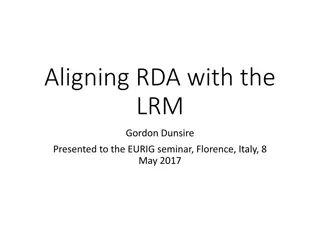New RDA Toolkit: Special Topics Overview
Delve into topics covering changes over time, types of descriptions, and developing attributes as relationships in the new RDA Toolkit. Explore the nuances of static and diachronic works, extension attributes, and the essence of diachronic work plans. Gain insights into the ROF extension attributes and "Extension expectation" categories.
Download Presentation

Please find below an Image/Link to download the presentation.
The content on the website is provided AS IS for your information and personal use only. It may not be sold, licensed, or shared on other websites without obtaining consent from the author.If you encounter any issues during the download, it is possible that the publisher has removed the file from their server.
You are allowed to download the files provided on this website for personal or commercial use, subject to the condition that they are used lawfully. All files are the property of their respective owners.
The content on the website is provided AS IS for your information and personal use only. It may not be sold, licensed, or shared on other websites without obtaining consent from the author.
E N D
Presentation Transcript
Preparing for the new RDA Preparing for the new RDA Toolkit: special topics Toolkit: special topics Gordon Dunsire, Deborah Fritz, Damian Iseminger Presented at the RSC outreach seminar National Library of Spain, Madrid, 23 Oct 2017 (amended)
Overview Topic 1: Serials, aggregates, and changes over time Topic 2: Types of description Topic 3: Developing attributes as relationships Slides 18 and 19 have been amended following discussion on meta-works vs work clusters by the RDA Steering Committee. Other slides have minor amendments.
1.1: Changes over time Static and diachronic works ROF extension attributes Extension expectation vocabulary
Static and diachronic works A static work is realized and embodied at the same time*. A diachronic work is realized and embodied in a duration of time**. * The content is issued in a single act ** The content is issued in a sequence of single acts that effectively change the content ***Time? Time-span entity?
Changing plans The essence of a diachronic work is the plan for the change of content: Replacement? = Integration Accumulation? = Succession The future may not conform with the plan The last episode of a TV serial is not made so we cannot describe a diachronic work (or expression or manifestation) until it is complete But we can describe the plan, and the distinct "issue" WEMs
ROF Extension attributes RDA/ONIX Framework for Resource Categorization Extension requirement: Not applicable Essential Inessential Static work "Monographic" work Continuing work Qualified by Extension mode (integration, succession) and Extension termination (determinate, indeterminate) to form "Extension expectation" categories
"Extension expectation" terms Static work A work intended to be realized in one or more distinct expressions that are embodied simultaneously. Integrating monographic work A work intended to be realized in one distinct expression embodied during a fixed time-span. Sequential monographic work A work intended to be realized in multiple distinct expressions embodied during a fixed time-span. Integrating continuing work A work intended to be realized in one distinct expression embodied during a time-span with no ending. Serial work A work intended to be realized in multiple distinct expressions embodied during a time-span with no ending. Aggregates?
1.2: Serial works Serial works and LRM relationships Change in work plan; WEM lock Boundary of serial work; ISSN and ISSN-L (clarified)
Serial work A work intended to be realized in multiple distinct expressions embodied during a time-span with no ending. Work-Work relationships LRM-R19 precedes [logical, not chronological] LRM-R22 was transformed into [by policy, etc.] Expression-Expression relationship: LRM-R25 was aggregated by
transformed into DiachronicW 1 DiachronicW 2 DiachronicE 1 DiachronicE 2 aggregated by aggregated by IssueE 1B IssueW 1B IssueW 1A IssueE 1A precedes precedes IssueW 2A IssueE 2A IssueE 2B IssueW 2B AggregateM AggregateM
Changes in Serial work plans LRM: The plan of a serial work includes the editorial concepts that guide the production of the issues that comprise an aggregate manifestation. Any changes to the plan may result in a new serial work. The national edition of El Pa s is a different serial work than the Valencia edition of El Pa s. The plan for the content has changed, resulting in a new serial work.
WEM lock (1) Because a serial work is also a plan for how a serial will be expressed and manifested, it may only have one expression and one manifestation. Just because something is true now, does not necessarily mean that it will be true in the future.
WEM lock (2) Translated editions should be treated as different expressions of different serial works. It is impossible to predict that a single serial work will always be published in both Spanish and Valencian. At some point, publication may cease for one of the language editions, but not the other.
WEM lock (3) Similarly, a serial released in an online version and a print version should be considered instances of 2 different serial works It is impossible to predict that a single serial work always be published in both a print and online version. It is also impossible to predict that the online and print versions will always share the same content.
Boundary of serial works A new serial work is generated when the plan for an already existing serial work changes. RDA will provide instructions for recording changes to elements associated with the plan for a serial work. But RDA can provide only general guidance on determining when a change of plan results in a new work.
Significance Change of: Frequency Carrier type Language Title Timeline of serial work transformed into SerialW A1 SerialW A2 SerialW B2 SerialW B1 transformed into transformed into
Judging boundaries It will be up to local policy and cataloguer s judgment to: Select the elements for describing the plan Select the elements for recording changes in their value Select the elements and values that justify the description of a new work Select the issue or iteration that provides the values used in a serial work This will prevent unnecessary proliferation of serial works.
ISSN and ISSN-L Because of the WEM lock, an ISSN should be understood as an identifier for a serial work, as opposed to an identifier for a manifestation. An ISSN-L should be understood as an identifier for a group of closely related serial works, i.e. a "work cluster". In this case it, is the same work in different mediums. In RDA, the relationship between the ISSN-L work cluster and the ISSN serial work can be indicated by recording the ISSN-L for each serial work.
Serial work cluster Serial Work Cluster has identifier Serial Work 1 ISSN 0264-2875 ISSN-L 0264-2875 ISSN-L 0264-2875 Serial Work 2 ISSN 1750-0095
1.3: Aggregates Types of aggregate Whole/part; Combination works Short-cuts through aggregating expressions
Types of aggregates An aggregate is a manifestation embodying multiple distinct expressions Aggregated Work 2 Aggregated Work 1 realizes Aggregated Expression 2 Aggregated Expression 1 embodies Aggregate Manifestation
Types of aggregates: 1 Aggregate collections of expressions W1: Danza ritual del fuego W2: Sombrero de tres picos realizes E1: Performance by Leonard Bernstein and the New York Philharmonic E2: Performance by Leonard Bernstein and the New York Philharmonic embodies M: Espan a (Columbia Records ML 6186)
Types of aggregates: 2 Aggregates resulting from augmentation W1: Don Quixote by Cervantes W2: Illustrations by Gustavo Dore realizes E1: Content Type: Text E2: Content type: Still image embodies M: Don Quijote de la Mancha (Madrid: Edimat Libros, 2004)
Types of aggregates: 3 Aggregates of parallel expressions W1: Beowulf (Epic poem) realizes E2: Text translated into Modern English by Seamus Heaney E1: Text in Old English embodies Beowulf (New York, 2000)
Plans for aggregates (1) Aggregate manifestations also embody an aggregating expression which realizes an aggregating work Aggregating Work Aggregated Work 1 Aggregated Work 2 realizes realizes Aggregating Expression Aggregated Expression 1 Aggregated Expression 2 embodies embodies Aggregate Manifestation
Plans for aggregates (2) The aggregating work is the plan, realized in the aggregating expression, for the selection and arrangement of the distinct expressions in the aggregate manifestation. AW: The plan for Understanding FRBR W2: W1: An introduction to Functional Understanding the AE: Expression of the plan . E2: Text in English E1: Text in English Understanding FRBR (Libraries Unlimited, 2007)
Plans for aggregates (3) The aggregating work does not contain the distinct works. There is no whole-part relationship AW: Work plan for Selected poetry of Lord Byron W2: To Belshazzar W1: She walks in beauty realizes realizes E1: Text in English E2:Text in English AE: Expression of the plan embodies embodies Selected poetry of Lord Byron (Modern Library, 2001)
What happens if the plan changes? Plans for aggregates (4) But there is a relationship, LRM-R25, between the aggregating expression and the expressions it selects AW: Work plan for Selected poetry of Lord Byron W2: To Belshazzar W1: She walks in beauty E1: Text in English E2:Text in English AE: Expression of the plan aggregated by Selected poetry of Lord Byron (Modern Library, 2001)
Whole/part works and expressions Whole/part works are distinct from aggregating works. The parts are always intended to belong to the whole. Each part of a whole/part work is realized by a corresponding part expression. Whole work 1 is part of is part of W: Chapter 1 W: Chapter 2 realizes E: Text of Whole Work 1 E: Text of Chapter 1 E: Text of Chapter 2 is part of is part of
Combination works Works that are conceived as whole, with contributions by one or more agents intended to be integral to the whole. They are neither whole-part nor aggregating works. Examples of combination works include: Silent films (moving image + text) Films with soundtracks (moving image + ) Songs (music + text) Graphic novels (still image + text)
Types of combination work Amalgamated content: Content of a single type that is associated with two or more different creator roles. The content cannot be separated from the combination work to derive a new work. Example: acting and lighting design in a motion picture Composite content: Content of two or more types that is associated with one or more creator roles. The content can be separated from the combination work to derive a new work. Example: music and libretto in an opera Performed expressions?
2.1: Description in context Description as (RDF) statements Semantic web applications Open World Assumption Attributes and relationships 4-fold path; distinct "records"
Resource Description Framework RDF (Resource Description Framework): the format of of the Semantic Web Data are recorded as triples: each triple is a single statement in subject-predicate-object order A description ("record") is one or more triples with the same subject: This Work [has] title of work "My title" This Work [has] creator That Agent
Open world description Semantic Web Open World Assumption: No data does not imply "not applicable". All description is open-ended; there is always something more that can be said about a subject entity. Work1 [has] title of work [has] creator [has] expression of work [Etc ] "My title" Agent2 Expression3 Work4 [is] remade as (work) [Etc the future]
Related descriptions A related entity (triple object) can be recorded as a "string" label or as an IRI. An object IRI can be the subject of another triple statement; a related entity may have its own description. Work1 [has] creator [Etc ] Agent2 Agent2 [has] name of agent [Etc ] "Jane Doe" Work1 [is] creator of
Recording descriptions A description can contain statements that mix "string" values with entity (or concept) IRIs. The same predicate element is used in statements with different kinds of object values. Work1 [has] creator [has] creator [has] creator [has] creator Agent2 "Jane Doe" "Doe, Jane, 1999-" "DoeJ99" Agent2 [has] name of agent [is] creator of "Jane Doe" Work1
2.2: Relating WEM Primary WEMI stack (locks) Item mediated thru Manifestation "Component" relationship types Whole-part Aggregates "Complementary" combination components Mode of issuance of manifestation Single and multi-unit
Primary WEMI relationships WEMI "stack" (primary FRBR relationships) Work realizes [1 and only 1 work] Expression embodies [1 or more expressions] Manifestation exemplifies [1 and only 1 manifestation] Item In LRM, most Item attributes and relationships are mediated via the (one and only one) Manifestation
Whole-part WEM relationships Whole "stack" has part "stacks" has part W: Whole W: Part realizes realizes has part E: Whole E: Part embodies embodies has part M: Whole M: Part
Aggregate WEM relationships W: Aggregating W: Aggregated realizes realizes aggregates E: Aggregating E: Aggregated embodies M: Aggregated
Serial WEM relationships Manifestation embodies one and only one expression ??? W: Serial W: Issue realizes [1 and only 1 work] aggregates E: Serial E: Issue embodies [1 and only 1 expression] ??? M: Serial M: Issue
Combination WEM relationships Component WEM is only described if it is separately embodied ??? W: Combination W: Libretto realizes has libretto E: Combination E: Libretto embodies ??? M: Combination M: Libretto
Mode of issuance of a manifestation A manifestation can be issued as either: a single unit, consisting of a single physical or logical unit. a multiple unit, consisting of two or more physical or logical units. A single unit can be a component of a multiple unit manifestation Manif1 [has] part [has] part Manif2 "Name of {Manif2}" [has] part Includes 20 discs" Manif2 [is] part of [is] part of Manif1 A 20 disc set
2.3: Issues Focus of description now entity-based "Analytical description" is a set of statements describing a component of a larger entity, and one of those statements might have an IRI or a string label for the larger entity as its object "Comprehensive description" is a set of statements describing a larger entity, and one of those statements might have an IRI or a string label for the component entity as its object Relationship with "coreness"
3.1: Attribute/relationship duality LRM RDA 4-fold path High-level relationship matrix
Attribute vs Relationship Distinction is blurred in LRM LRM optimized for Semantic Web applications Distinction determined by data Web Ontology Language (OWL): Data value is a string (literal) OWL datatype attribute element Data value is a thing (IRI): entity or concept/term OWL object relationship element RDA Recording methods (4-fold path)
Recording methods for related data "note on related entity" "access point for related entity" RDA Entity 1 is associated with (related to) "identifier for related entity" has attribute / relationship RDA Entity 2 "unstructured description" "structured description" datatype property "identifier" object property IRI
High-level relationship matrix is associated with (related to) W W E E F C M M Collective Agent I I Agent Agent P Nomen Nomen Place Place Time-span Time-span
3.2: Impact on RDA elements New LRM entities Cross-over attribute elements Hierarchies and inverses
Dates, names, and places "madrid" "Madrid (Spain)" "Madrid" has place of publication "MAD" Place "2017" m has date of publication Timespan "title proper" has title proper Nomen
